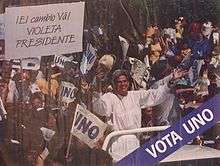National Opposition Union (1989)

National Opposition Union (Unión Nacional Opositora—UNO) was a wide-range cartel of opposition parties formed to contest Nicaragua's president Daniel Ortega in the 1990 election. Its candidate Violeta Chamorro eventually won the race. UNO traced its origins back to the Nicaraguan Democratic Coordinating Group (Coordinadora Democrática Nicaragüense—CDN), which was formed in 1982 by different opposition groups. At the time of the election, of the UNO coalition's fourteen political parties, four were considered conservative, seven could be characterised as centrist parties, and three - including Nicaragua's Communists - had traditionally been on the far left of the political spectrum (see ).
Despite internal struggle, the UNO coalition under Violeta Chamorro succeeded in its campaign centered on the economic downfall and promises of peace. Chamorro promised to end military draft, initiate democratic reconciliation, and restore economic growth. Many Nicaraguans felt that the contra war and bad economy would continue if the FSLN remained in power, because of the strong United States opposition to the FSLN (the Bush Administration had declared that it would only send aid to the government if the UNO was elected).
Meanwhile, resources and organisational help were given to the UNO by the United States government's National Endowment for Democracy (NED), which in June 1989 had receive $2 million from U.S. Congress, which had also approved in April 1989 a package of $49.75 million in 'nonlethal' aid to the Contras, which funded their pro-UNO propaganda campaign. Some villages reported threats of murder from the Contras if they voted for the FSLN in the elections.

In presidential election held on February 25, 1990, Violeta Barrios de Chamorro won 55% of the popular vote against Daniel Ortega's 41%. .
The UNO disbanded in mid-1990s, after a very fractious rule during which little progress was made. The most positive consequence of their electoral victory was the end of the Contra War and the U.S. economic embargo.
Member parties
| Political party | Orientation | Leader |
|---|---|---|
| Alianza Popular Conservadora (Popular Conservative Alliance). | right-wing | Míriam Argüello Morales |
| Movimiento Democrático Nicaragüense (Nicaraguan Democratic Movement) | centrist | Roberto Urroz Castillo |
| Partido de Acción Nacional (National Action Party) | centrist | Eduardo Rivas Gasteazoro |
| Partido de Acción Nacional Conservadora (Conservative National Action Party). | right-wing | Hernaldo Zúñiga Montenegro |
| Partido Comunista de Nicaragua (Communist Party of Nicaragua) | left-wing | Eli Altimirano |
| Partido Conservador Nacional (National Conservative Party) | right-wing | Silviano Matamoros Lacayo |
| Partido Demócrata de Confianza Nacional (Democratic Party of National Confidence) | centrist | Agustín Jarquín Anaya |
| Partido Integracionalista Centroamericano (Central American Integrationist Party) | Alejandro Pérez Arévalo | |
| Partido Liberal (Liberal Party) | Andrés Zúñiga Mercado | |
| Partido Liberal Constitucionalista (Liberal Constitutionalist Party) | right-wing | José Somarriba |
| Partido Liberal Independiente (Independent Liberal Party) | centrist | Virgilio Godoy Reyes |
| Partido Popular Social Cristiano (Social Christian Popular Party) | centrist | Luis Guzmán |
| Partido Social Demócrata (Social Democratic Party) | centre-right | Guillermo Potoy |
| Partido Socialista Nicaragüense (Nicaraguan Socialist Party) | left-wing | Gustavo Tablada Zelaya |
The APC, PANC, and PCN announced in 1992 that they would merge as the National Conservative Party (Partido Conservador Nationalista—PCN) for the 1996 elections.
Source: http://www.country-data.com/frd/cs/nicaragua/ni_appen.html#table10
External links
- http://www.country-data.com/cgi-bin/query/r-9286.html
- http://www.nicaraguasc.org.uk/aboutnicaragua/from1979.htm